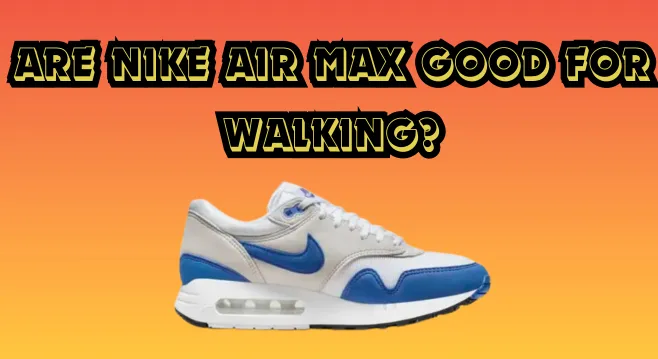If you’re a sneaker enthusiast or someone who appreciates comfort and style, the Nike Air Max line has likely caught your attention. These iconic shoes, known for their visible Air cushioning units, have been a staple in the sneaker world for decades.
However, one question that often arises is whether Nike Air Max shoes are suitable for walking. In this article, we’ll dive deep into this topic and explore the pros and cons of wearing Nike Air Max shoes for extended periods of walking.
The Design and Construction of Nike Air Max Shoes
Before we delve into the walking aspect, it’s essential to understand the design and construction of Nike Air Max shoes. The Air Max line is renowned for its innovative Air cushioning technology, which was first introduced in 1978 with the release of the Air Sole unit.
The Air cushioning system consists of pressurized air pockets or units strategically placed in the midsole of the shoe.
These air pockets are designed to compress and provide cushioning and shock absorption with each step, offering a smooth and comfortable ride.
In addition to the Air cushioning units, Nike Air Max shoes feature various other design elements that contribute to their overall comfort and performance.
Many models incorporate a combination of lightweight materials, such as mesh, synthetic overlays, and foam midsoles, providing breathability, support, and durability.
Factors to Consider
When evaluating whether Nike Air Max shoes are good for walking, several factors come into play:
Distance and Duration
If you’re planning on taking casual strolls or running errands, Nike Air Max shoes can be a suitable option. Their Air cushioning units and shock-absorbing properties can provide comfort for shorter distances.
However, if you’re planning on walking for extended periods or covering long distances, you may want to consider dedicated walking or hiking shoes.
Terrain
Nike Air Max shoes are generally designed for urban environments and flat surfaces. Their cushioning system excels on paved paths, sidewalks, and roads.
However, if you plan to walk on rough terrain, such as hiking trails or uneven surfaces, you may find that the Air Max shoes lack the necessary traction and support.
Weight and Cushioning
One of the strengths of Nike Air Max shoes is their cushioning and shock absorption capabilities. The Air units in the midsole help dissipate impact forces and provide a responsive, comfortable ride.
This can be particularly beneficial for those who walk on hard surfaces or carry extra weight, as it can help reduce stress on the joints and feet.
Arch Support
While Nike Air Max shoes offer excellent cushioning, some models may lack adequate arch support. Proper arch support is crucial for preventing foot pain, heel pain, and other related issues during extended periods of walking.
If you have specific arch support needs, you may want to consider adding custom orthotics or insoles to your Nike Air Max shoes.
Alternatives and Modifications
If you’re set on wearing your Nike Air Max shoes for walking but want to mitigate some potential downsides, there are a few alternatives and modifications to consider:
Insoles or Orthotics
Adding a pair of high-quality insoles or custom orthotics to your Nike Air Max shoes can significantly improve their comfort and support.
Insoles can provide additional cushioning, arch support, and shock absorption, making your Air Max shoes more suitable for walking.
Nike Walking Shoes
While the Air Max line is primarily designed for lifestyle and athletic purposes, Nike also offers specific walking shoe models.
These models, like the Nike Air Monarch or the Nike Revolution, are engineered with features tailored for walking, such as enhanced stability, traction, and support.
Alternative Walking Shoes
If walking is your primary activity, it may be wise to invest in a pair of dedicated walking shoes from brands known for their high-quality walking and hiking footwear.
These shoes are specifically engineered for comfort, support, and traction during extended periods of walking on various terrains.
Maintaining Your Nike Air Max Shoes
Regardless of whether you decide to wear your Nike Air Max shoes for walking or opt for more suitable alternatives, proper maintenance is crucial. Here are a few tips to keep your Air Max shoes in good condition:
Clean them regularly:
Nike Air Max shoes can accumulate dirt, sweat, and stains, which can affect their appearance and performance. Use a soft brush and mild soap to gently clean them, ensuring they stay fresh and maintain their aesthetic appeal.
Replace the insoles:
Over time, the insoles in your Nike Air Max shoes will wear down and lose their cushioning. Consider replacing them with new insoles periodically to maintain comfort and support.
Check the outsoles:
Inspect the outsoles regularly for signs of excessive wear or smooth spots, which can reduce traction and increase the risk of slips or falls.
Rotate your shoes:
Alternating between different pairs of shoes can help extend the lifespan of your Nike Air Max shoes and prevent excessive wear and tear.
Frequently Asked Questions (FAQs)
Can I wear Nike Air Max shoes for running?
While Nike Air Max shoes are designed with cushioning and shock absorption in mind, they are primarily intended for lifestyle and casual wear.
For high-impact activities like running, it’s generally recommended to opt for dedicated running shoes that offer more specialized support and stability features.
Are Nike Air Max shoes good for standing all day?
While the Air cushioning units in Nike Air Max shoes can provide comfort for short periods of standing, they may not be the ideal choice for extended periods of standing or being on your feet all day.
Prolonged standing can lead to foot fatigue and discomfort due to the lack of specific support features found in occupational or specialized standing shoes.
Do Nike Air Max shoes provide good ankle support?
Most Nike Air Max shoes are designed with a low-cut silhouette, which means they offer minimal ankle support.
This can increase the risk of ankle sprains or rolls, especially during activities that involve sudden movements or changes in direction.
If you require additional ankle support, you may want to consider shoes with a higher collar or dedicated ankle support features.
Can I wear Nike Air Max shoes for hiking?
It is generally not recommended to wear Nike Air Max shoes for hiking.Hiking often involves uneven terrain, steep inclines, and rough surfaces, which require shoes with proper traction, stability, and support features.
Nike Air Max shoes are primarily designed for urban environments and may not provide the necessary grip and protection for challenging hiking conditions.
Are there waterproof Nike Air Max shoes?
While some Nike Air Max models may feature water-resistant or water-repellent materials, most are not fully waterproof.
The materials used in the construction of Air Max shoes, such as mesh and synthetic overlays, can still allow water and moisture to seep in during wet conditions.
If you need a waterproof shoe, it’s best to consider dedicated outdoor or hiking shoes designed specifically for wet environments.
Conclusion
In conclusion, while Nike Air Max shoes are undoubtedly stylish and comfortable, their suitability for walking depends on various factors, such as distance, terrain, and personal preferences.
For casual, short walks on flat surfaces, Nike Air Max shoes can be a comfortable option, thanks to their Air cushioning units and shock-absorbing properties.
However, for extended periods of walking or more demanding activities, it’s advisable to consider shoes specifically designed for walking or hiking to ensure proper support, traction, and stability.
Ultimately, listening to your body and being mindful of any discomfort or pain is crucial when deciding whether Nike Air Max shoes are the right choice for your walking needs.

